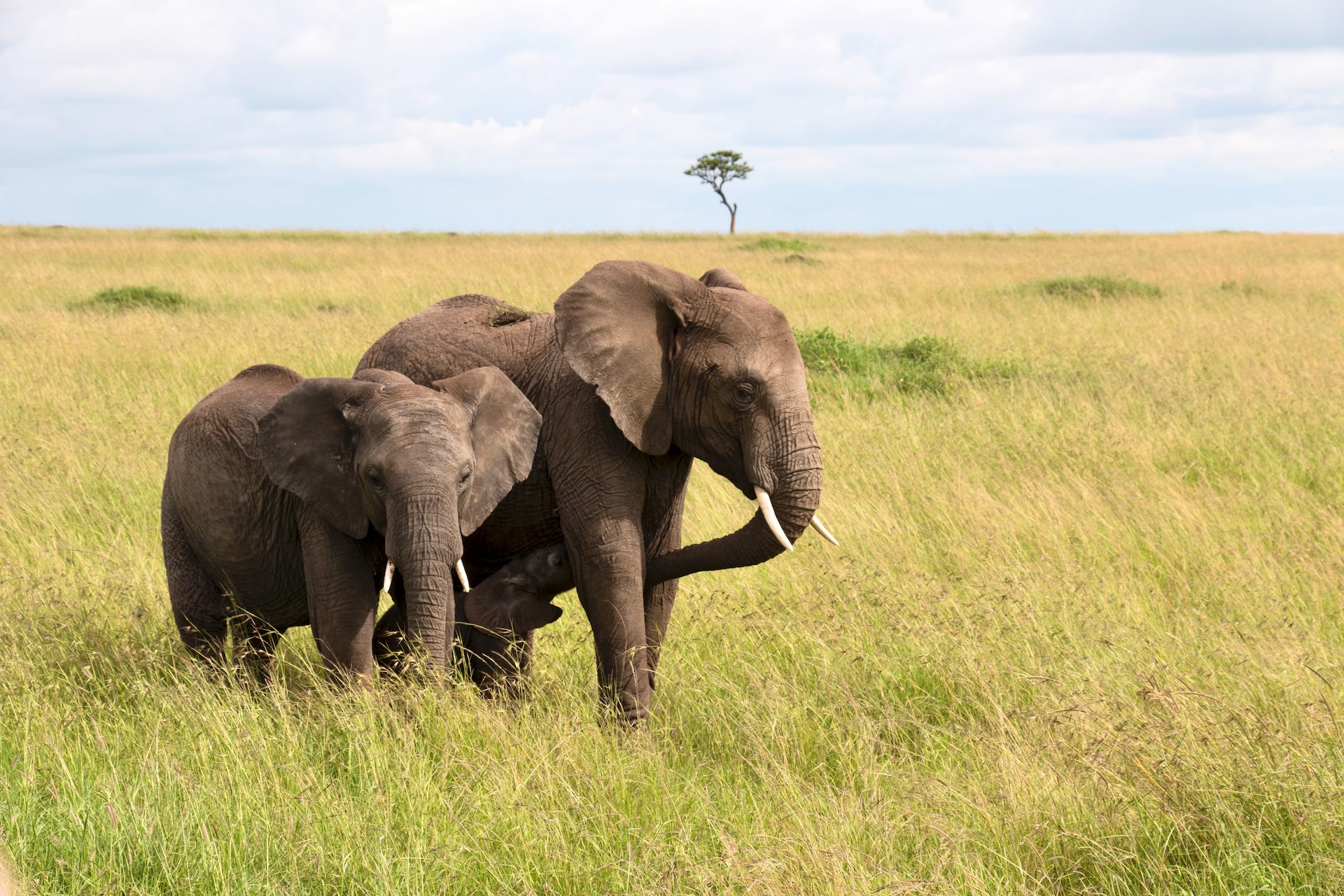Fascinating Life of Elephants: Top 20 Facts | Documentary

Welcome to our incredible journey into the world of elephants!
In this episode, we uncover 20 captivating facts about these majestic creatures – from their impressive intelligence and emotional depth to their crucial role in shaping their ecosystem. Discover the fascinating self-awareness of elephants as they recognize themselves in mirrors, and marvel at their exceptional memory that allows them to remember old friends and specific locations.
Join us as we delve into their intricate social structure and how they form lifelong bonds with each other.
Explore their immense size, agility, and unique communication methods. Witness the extraordinary ways elephants keep cool on hot days, and uncover their altruistic behaviour towards other animals.
Discover why elephants are vital to maintaining the delicate balance of their environment. Prepare to be amazed by these magnificent giants of the animal kingdom!
And remember, your support keeps us going, so make sure to like, comment, and share this video with fellow wildlife enthusiasts. Together, let’s celebrate the wonders of the animal kingdom, one fascinating fact at a time.
Fact #1:
Did you know that elephants are one of the few animals that are self-aware? In fact, they are one of the only animals that can recognize themselves in a mirror! This means that they have a sense of individuality and are aware of their own existence.
Scientists have conducted experiments where they place a mark on an elephant’s forehead and then show them a mirror. The elephant will then touch the mark on their forehead, indicating that they recognize themselves in the mirror. This ability to recognize oneself is not only fascinating, but it also shows that elephants have a high level of intelligence.
Fact #2:
Elephants are known for their incredible memory. They can remember other elephants they have met, even if it has been years since they last saw them! They can also remember specific locations, such as watering holes, and will return to them year after year.
This impressive memory is one of the reasons why elephants are such great problem solvers. They can remember solutions to problems they have encountered before and apply them to new situations.
Fact #3:
Elephants are social animals and live in groups called herds. These herds are usually led by a matriarch, who is the oldest and most experienced female in the group. The matriarch is responsible for leading the herd to food and water sources and for making important decisions for the group.
Elephants also have a strong sense of community and will help each other in times of need. For example, if a baby elephant is in danger, other elephants in the herd will come to its rescue.
Fact #4:
Elephants are the largest land animals on Earth, with the African elephant being the largest of the two species. Adult African elephants can weigh up to 6,000 kg and stand up to 13 feet tall. Despite their size, elephants are surprisingly agile and can run up to 25 mph! They also have an incredible sense of smell and can detect water sources from up to 12 miles away.
Fact #5:
Elephants are very emotional animals and have been known to display a wide range of emotions, including joy, love, grief, and even empathy. They have been observed mourning the death of other elephants and will often stay with the body of a deceased elephant for days.
They also show empathy towards other animals, including humans. There have been numerous accounts of elephants coming to the aid of humans in distress, such as helping to lift a car that had overturned.
Fact #6:
Elephants are herbivores and can consume up to 300 pounds of food in a single day! Their diet consists mainly of grasses, leaves, bark, and fruits. They use their long trunks to pick up food and then transfer it to their mouths. Interestingly, elephants also have four sets of teeth throughout their lifetime, with each set lasting for about 10 years. When their last set of teeth wears down, they can no longer chew their food properly and will eventually die of starvation.
Fact #7:
Elephants have a unique way of communicating with each other. They use a variety of sounds, including trumpets, rumbles, and grunts, to communicate with members of their herd. These sounds are produced by the elephant’s vocal cords and can be heard from miles away.
In addition to vocalizations, elephants also use body language to communicate. For example, they will flap their ears or raise their trunks as a sign of aggression.
Fact #8:
Elephants are one of the few animals that can recognize different languages! In a study conducted in Kenya, elephants were able to distinguish between the languages of two different tribes. When they heard the language of a tribe that was known for hunting elephants, they reacted with fear and fled, while they were calm when they heard the language of a tribe that did not hunt them.
Fact #9:
Elephants have a unique way of cooling themselves down. They use their large ears as radiators, flapping them back and forth to cool the blood flowing through the vessels in their ears. This is why you’ll often see elephants flapping their ears, especially on hot days. In addition to this, they also use mud baths to cool down and protect their skin from the sun.
Fact #10:
Elephants have a special relationship with their environment. They play an important role in maintaining the balance of their ecosystem by creating and maintaining habitats for other animals. For example, they create paths through the forest by breaking branches and trampling vegetation, which allows other animals to move through the forest more easily. They also help to disperse seeds by eating fruits and then excreting the seeds in their feces.
Fact #11:
Elephants have a complex social structure that is similar to that of humans. They form close bonds with each other and even mourn the death of their companions. Female elephants, in particular, are known for their strong social bonds.
They will often stay together for their entire lives and help each other raise their young. Male elephants, on the other hand, tend to be more solitary and will only join groups of females during mating season.
Fact #12:
Elephants have an incredible sense of hearing. They can detect sounds that are too low or too high for humans to hear, and can even communicate with each other through vibrations in the ground. This sense of hearing is essential for elephants, as it allows them to communicate over long distances and detect potential dangers. In fact, elephants can detect the sound of approaching predators from up to six miles away!
Fact #13:
Elephants are capable of experiencing a wide range of emotions, including happiness, sadness, anger, and fear. They have been observed displaying emotions that are similar to those of humans, such as joy when they reunite with a long-lost companion or grief when a member of their herd dies. In addition to this, elephants have also been observed comforting each other during times of stress or discomfort.
Fact #14:
Elephants are skilled swimmers and can cross large bodies of water with ease. They use their trunks as snorkels and can swim for hours at a time without getting tired. In addition to this, elephants are also able to use their trunks as a form of snorkel when they need to breathe while submerged. This is why you’ll often see elephants swimming with only their trunks above the water.
Fact #15:
Elephants are incredibly intelligent animals and have been trained to perform a wide range of tasks by humans. In Asia, elephants have been used for centuries in the logging industry, where they are used to move heavy logs through the forest.
They have also been trained to perform in circuses and other entertainment shows. However, in recent years, there has been a growing movement to end the use of elephants for entertainment, as it is considered cruel and inhumane.
Fact #16:
Elephants are highly intelligent and have incredible problem-solving abilities. In one study, researchers presented elephants with a problem: how to retrieve food from a box that was too heavy to move.
The elephants quickly figured out that they could use sticks to push the box and get to the food inside. What’s even more impressive is that they remembered the solution to the problem even after a year had passed!
Fact #17:
Elephants have a special relationship with their tusks. Their tusks are actually elongated incisor teeth that can grow up to 8 feet long and weigh up to 100 pounds! Tusks are used for a variety of purposes, such as digging for roots and water, defending themselves against predators, and fighting for dominance within their herd. Unfortunately, tusks are also highly valued in the illegal ivory trade, which has led to a significant decline in elephant populations.
Fact #18:
Elephants have a unique way of communicating with each other that is not audible to humans. They use low-frequency sounds, known as infrasound, to communicate over long distances. These sounds are so low that they can travel for up to 6 miles without being detected by predators or humans. In addition to this, elephants also use infrasound to detect storms and earthquakes, which allows them to take evasive action before the danger arrives.
Fact #19:
Elephants are capable of exhibiting altruistic behaviour towards other animals. In one case, a herd of elephants in Kenya came across a group of distressed oryx antelopes that were trapped in a muddy waterhole.
The elephants used their trunks to lift the oryx out of the water and onto dry land, saving their lives. This behaviour is not uncommon among elephants, as they have been known to help other animals in distress, including humans.
Fact #20:
Elephants have a profound impact on their environment. As they move through the forest, they create clearings and paths that allow sunlight to reach the forest floor. This promotes the growth of new vegetation, which provides food and shelter for other animals.
In addition to this, elephants also help to maintain the balance of their ecosystem by controlling the growth of certain plant species. Without elephants, their habitats would be drastically altered, which could have a negative impact on their entire ecosystem.
And that concludes our episode on fascinating facts about elephants! We hope you learned something new about these incredible animals. And if you have any other interesting facts about elephants, let us know in the comments below!
If you’ve enjoyed this exploration, don’t forget to hit that subscribe button and ring the notification bell to join our wildlife-loving community. Together, we’ll continue to unravel the secrets of the animal kingdom, showcasing the beauty and diversity of our natural world.
Thank you for being a part of this awe-inspiring adventure with us. Your support and enthusiasm drive us to create more fascinating content that celebrates the wonders of nature. So, until our next thrilling expedition, keep exploring, keep learning, and keep spreading the knowledge. Remember, it’s the shared love for wildlife that unites us all. See you in the next captivating exploration!
Stay tuned for more captivating content right here, and until next time, keep exploring, keep learning, and keep spreading the knowledge!





